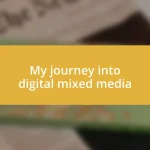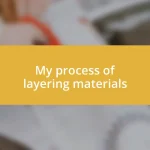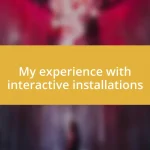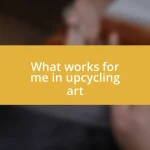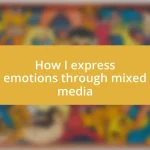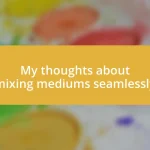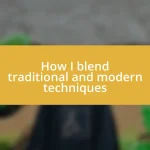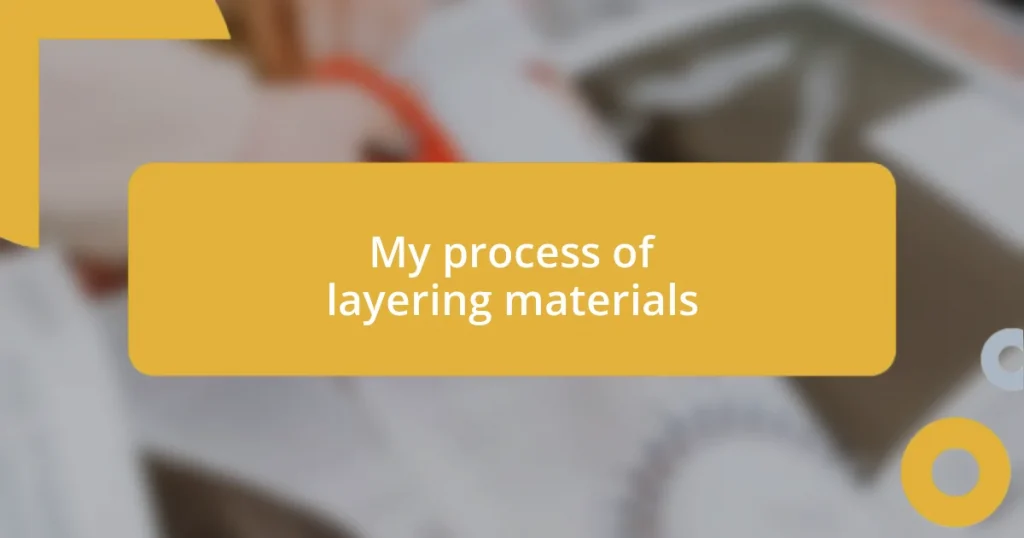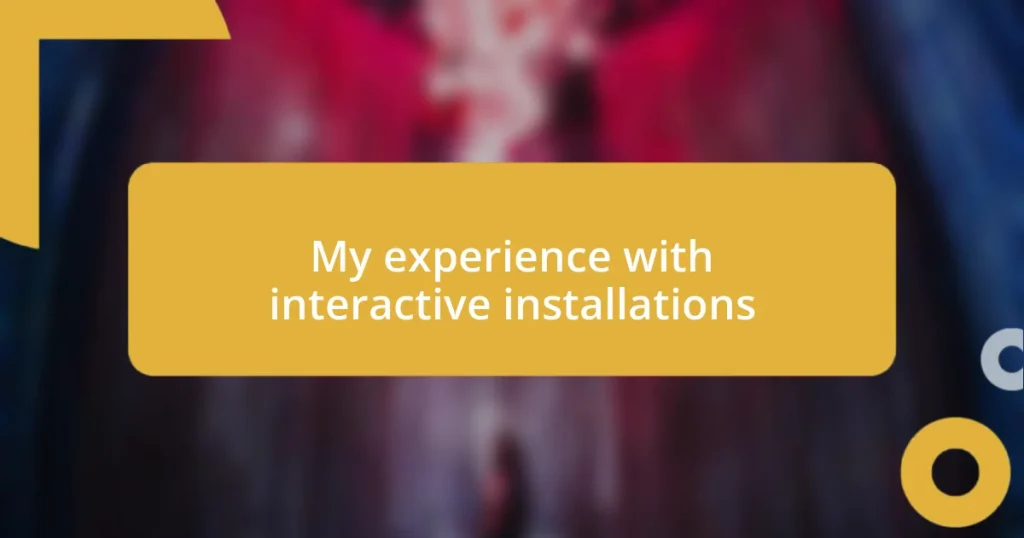Key takeaways:
- Understanding color theory and the emotional impact of colors are crucial for artists to effectively convey mood and meaning in their artwork.
- Experimenting with various color palettes, mixing techniques, and contrasts can enhance visual interest and depth in mixed media projects.
- Finalizing artwork involves careful assessment and small detail adjustments, as well as the application of protective finishes to enhance vibrancy and unity.

Understanding color theory basics
Color theory is a fascinating aspect of art that profoundly influences how we perceive emotion and structure our work. I remember the first time I mixed complementary colors like blue and orange; it felt like magic. The way they vibrated against each other brought my art to life in a way that I had never experienced before. Have you ever noticed how certain color combinations can evoke strong feelings?
Understanding the color wheel is crucial. It’s like a roadmap for artists. I once spent hours experimenting with primary colors, gradually building my palette. This journey made me appreciate how mixing these basic hues creates a universe of shades—each carrying its own mood and message. Isn’t it incredible how a simple change in hue can shift the entire tone of a piece?
The emotional impact of colors can’t be overstated. Warm colors like reds and yellows can energize a piece, while cooler shades like blues and greens often create calm. I’ve found that using warm colors in portraits can evoke intimacy and warmth, drawing viewers in. How do you want your audience to feel when they look at your artwork? It’s a question worth pondering as you navigate the world of color.

Choosing the right color palette
Choosing the right color palette can be both exciting and daunting. I still vividly recall a project where I selected a soft pastel palette for a serene landscape. The moment I applied the delicate pinks and blues, a sense of tranquility enveloped the whole piece. Do you feel that certain colors can help set the mood even before you dive into the details?
When considering your palette, it’s essential to keep your theme and message in mind. I often create mini color tests on scraps of paper to see how different hues interact before committing them to my artwork. This process not only saves me from committing to a palette that may clash but also helps me discover surprising harmonies that truly resonate with my intentions. Have you tried experimenting in such a way?
Lastly, remember that contrast can be your ally. In one of my favorite mixed media projects, I juxtaposed vibrant oranges against subdued grays, creating a dynamic tension that sparked a conversation among viewers. This balance can enhance your focal points while guiding the viewer’s eye throughout your composition. How do you envision the relationship between colors and the story of your work?
| Color Palette Type | Emotional Impact |
|---|---|
| Monochromatic | Creates unity and harmony |
| Analogous | Evokes tranquility and calm |
| Complementary | Conveys energy and vibrancy |
| Triadic | Injects excitement and dynamism |

Techniques for mixing colors
Mixing colors is one of the most fulfilling experiences in mixed media art. I often experiment with colors using a palette knife instead of a brush. The way the colors blend and create unexpected textures is truly fascinating. Plus, there’s something incredibly satisfying about the physicality of it. Other techniques I enjoy include layering transparent washes or building up opaque layers for depth. Each method offers a unique way to perceive color relationships that can transform a piece.
Here are some techniques that I frequently implement for mixing colors:
- Wet-on-wet: Applying wet paint to a wet surface allows colors to bleed into one another, creating beautiful blends.
- Glazing: Using thin, transparent layers can achieve luminosity while altering the color beneath.
- Color scraping: Scraping away layers of paint reveals underlying colors and textures, adding depth to the work.
- Dry brushing: Using a dry brush with little paint creates a texture that highlights the underlying layers.
- Sponge application: This technique allows for softer transitions between colors and can evoke a sense of movement or softness.
I can’t stress enough how these techniques can yield surprising results and keep the creative process engaging. It’s like each mix brings a new story to life on your canvas.

Using color in backgrounds
When I create backgrounds, I love to think of them as the foundation of my artwork’s story. In one project, I decided to use deep indigo and golden yellows for the background of a cityscape. The dark indigo offered a sense of depth, while the bold yellow brought light and warmth, creating an inviting atmosphere that immediately captivated viewers. Have you considered how a well-crafted background can set the stage for your main subject?
I often employ a variety of textures when working on backgrounds. For example, I remember a piece where I layered crumpled tissue paper under acrylic washes to create an organic, vibrant texture. This method added a level of intrigue that drew others in and made them ponder the complexity of the piece. It’s fascinating how a simple technique can turn a flat surface into something that invites touch and exploration. What textures do you love to incorporate?
Color gradients are another powerhouse tool in background creation. I recall an abstract piece where I used a gradient from soft lavender to bright fuchsia. The transition was so smooth that it felt almost ethereal, lending the entire work a dream-like quality. Such gradients can evoke a range of emotions and invite viewers to lose themselves in the colors. Have you found yourself experimenting with gradients, and how do they affect your art?

Enhancing focal points with color
To enhance focal points with color, I often choose a contrasting shade to draw the viewer’s eye towards the main subject. In one of my pieces featuring a serene landscape, I used vibrant reds and oranges to highlight the sun setting over muted greens and browns. This technique not only created visual interest but also evoked a sense of warmth and tranquility.
I’ve also had great success using color saturation to emphasize focal points. When I painted a still life, I intentionally made the fruit more saturated than the background, allowing those colors to leap off the canvas. The contrast not only made the fruit pop but also created an interactive experience, inviting viewers to focus on the details and imagine the flavors of the fruit.
Another approach I enjoy is creating a color “path” leading to my focal point. For instance, in a dynamic abstract piece, I blended softer hues around the edges while intensifying the color near the center. This technique naturally guided viewers’ eyes to that area, fostering a connection with the art itself. Have you tried using color pathways in your work? It’s a simple yet impactful way to direct attention, and it can dramatically elevate your composition.

Experimenting with color contrasts
Experimenting with color contrasts can open up a world of creativity in mixed media. I once worked on a piece that featured vibrant turquoise juxtaposed with deep maroon. The interplay between these colors was electrifying; as I layered them, I felt an almost tangible energy that transformed the composition from ordinary to extraordinary. Have you ever felt that rush when two colors clash harmoniously on your canvas?
One of my favorite techniques involves using complementary colors to create striking contrasts. I remember a collage where I combined bright orange with its counterpart, a deep blue. It was mesmerizing to see how the two colors seemed to vibrate against each other, adding depth and drama. If you haven’t explored complementary colors yet, I encourage you to consider how they could add that extra punch to your artwork.
In my experience, experimenting with unexpected contrasts can lead to surprising results. There was a mixed media project where I paired pastel pinks with strong, dark blacks. That unusual combination challenged my initial instincts, but as I continued to layer and adjust, the piece developed a unique character that was both playful and intense. What unexpected color combinations have you tried? Sometimes, stepping out of our comfort zones can yield the most rewarding discoveries.

Finalizing your mixed media artwork
Finalizing your mixed media artwork can feel like both an exhilarating and challenging step. I often find myself standing back to assess the overall balance of colors and textures. There’s a moment of hesitation before I make those final adjustments, knowing that a single stroke might enhance or detract from the piece. Have you experienced that blend of excitement and anxiety as you approach the finish line?
One technique I love when finalizing my work is adding small details using a fine brush or marker. For instance, I once dotted a contrasting color along the edges of a collage. This small change brought the entire piece to life, creating visual continuity that tied the components together seamlessly. It’s amazing how a little detail can make such a significant impact. Have you considered how minor alterations might transform your own artwork?
Finally, I never overlook the power of a protective finish when wrapping up my mixed media pieces. I’ve learned that adding a layer of varnish not only seals my colors but also enhances their vibrancy, making the artwork feel complete. There’s something satisfying about seeing everything come together, almost like watching a favorite recipe transform in the oven. What finishing touches do you find essential for your own artistic process?
